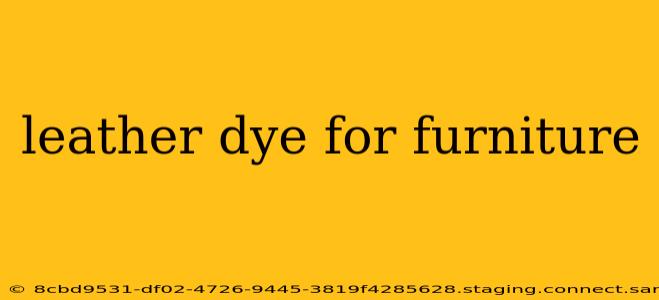Leather furniture adds a touch of elegance and sophistication to any home. However, over time, leather can fade, scratch, and show signs of wear. Fortunately, restoring your leather furniture's beauty is achievable with the right leather dye. This comprehensive guide explores everything you need to know about using leather dye for furniture, from choosing the right dye to applying it correctly and maintaining the results.
What is Leather Dye?
Leather dye is a specialized colorant designed to penetrate the surface of leather, changing its color and restoring its vibrancy. Unlike leather paint, which sits on top of the leather, dye interacts with the leather fibers, resulting in a more natural and long-lasting finish. Different types of dyes exist, including water-based, oil-based, and solvent-based, each with its own advantages and disadvantages. Choosing the right type is crucial for a successful project.
What are the Different Types of Leather Dye?
Water-Based Leather Dye
Water-based dyes are the most popular choice for beginners due to their ease of use and water cleanup. They tend to be less vibrant than oil-based dyes, but offer good penetration and are less likely to crack or peel.
Oil-Based Leather Dye
Oil-based dyes offer richer, more intense colors. However, they require more specialized application techniques and solvents for cleanup. They are more durable and resistant to fading compared to water-based dyes.
Solvent-Based Leather Dye
Solvent-based dyes provide exceptional durability and vibrant colors. However, they are the most toxic and require careful handling and ventilation. They are generally reserved for professionals due to their complexity.
How to Choose the Right Leather Dye for Your Furniture?
Selecting the correct leather dye depends on several factors:
- Type of Leather: Different types of leather (e.g., full-grain, top-grain, bonded) absorb dye differently. Testing a small, inconspicuous area is crucial before applying dye to the entire piece.
- Desired Color: Choose a dye that closely matches your desired shade. Consider using a sample size to ensure color accuracy.
- Dye Type: Consider your experience level and the desired durability when choosing between water-based, oil-based, or solvent-based dyes.
How to Apply Leather Dye to Furniture?
Proper application is key to achieving a professional-looking finish. Here's a step-by-step guide:
- Preparation: Clean the leather thoroughly using a specialized leather cleaner. Allow it to dry completely.
- Testing: Apply a small amount of dye to an inconspicuous area to test the color and ensure compatibility.
- Application: Use a sponge, brush, or spray applicator, depending on the dye type and your preference. Apply thin, even coats, allowing each coat to dry completely before applying the next.
- Drying: Allow the dye to dry thoroughly according to the manufacturer's instructions. This may take several hours or even overnight.
- Finishing (Optional): Apply a leather conditioner or sealant to protect the dyed leather and enhance its longevity.
What are the Best Brands of Leather Dye?
Several reputable brands offer high-quality leather dyes, including Fiebing's, Angelus, and Eco Flo. Researching reviews and comparing products will help you find the best option for your specific needs and budget. Remember to always follow the manufacturer's instructions for best results.
How to Remove Leather Dye from Furniture?
Accidental spills or unsatisfactory results can be disheartening. The removal process depends on the type of dye used. Water-based dyes are generally easier to remove with soap and water, while oil-based and solvent-based dyes might require specialized solvents. Always test any cleaning method on an inconspicuous area first.
How Long Does Leather Dye Last?
The longevity of leather dye depends on several factors, including the type of dye used, the quality of the application, and the care of the leather. With proper care and maintenance, a good quality leather dye can last for several years.
Can I Dye Leather Furniture Myself, or Should I Hire a Professional?
While dyeing leather furniture is a DIY-friendly project, hiring a professional might be beneficial if you're dealing with a large or valuable piece of furniture or lack experience. Professionals possess the expertise and tools to ensure optimal results.
What are the Potential Problems with Dyeing Leather Furniture?
Potential problems include uneven application, color inconsistencies, and cracking or peeling if not applied correctly. Proper preparation, application, and aftercare are crucial to minimizing these issues.
This comprehensive guide provides a solid foundation for tackling your leather furniture dyeing project. Remember careful preparation and meticulous application are key to achieving a professional, long-lasting result. Happy dyeing!

